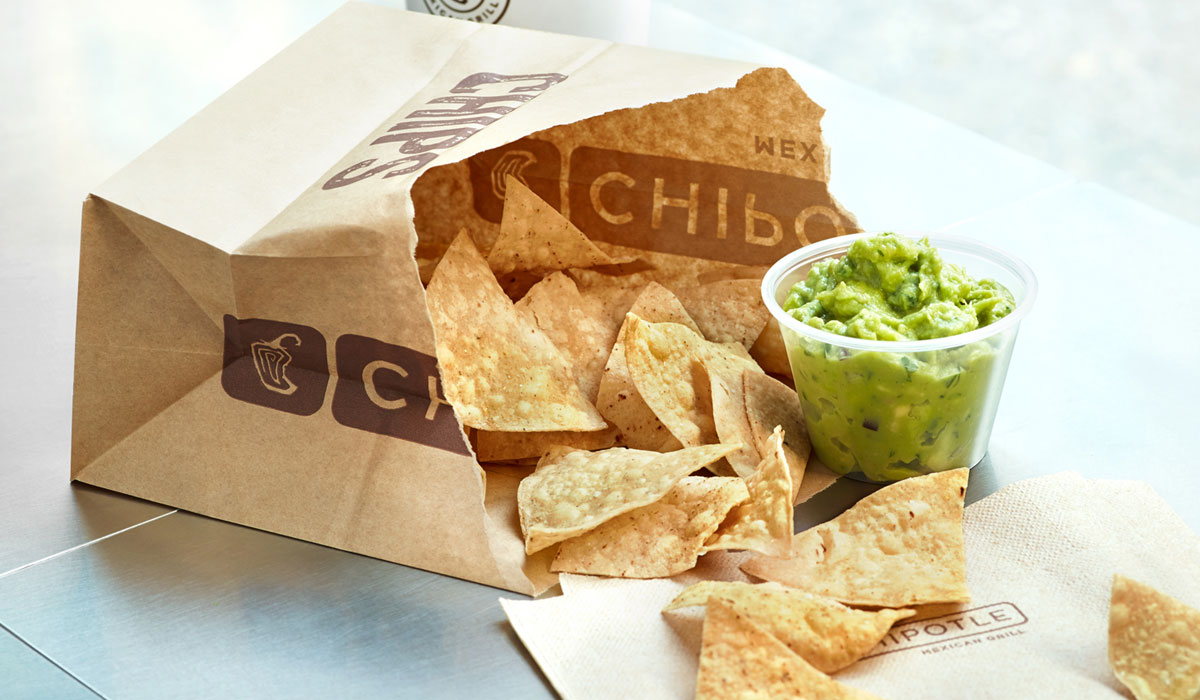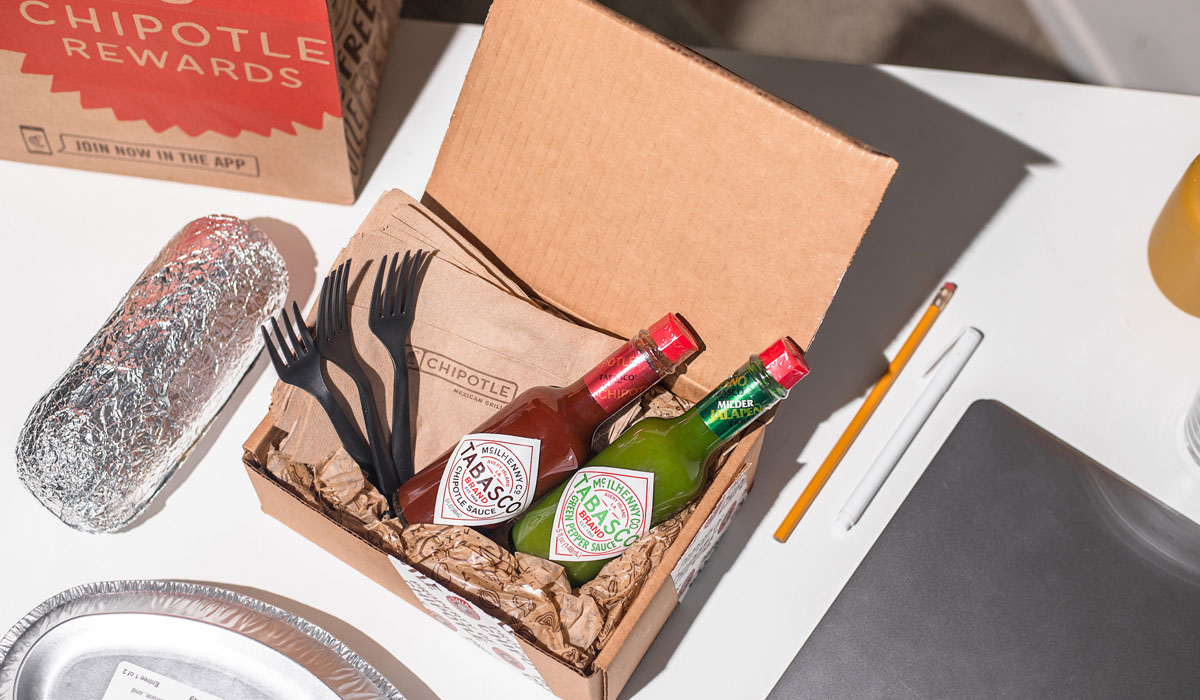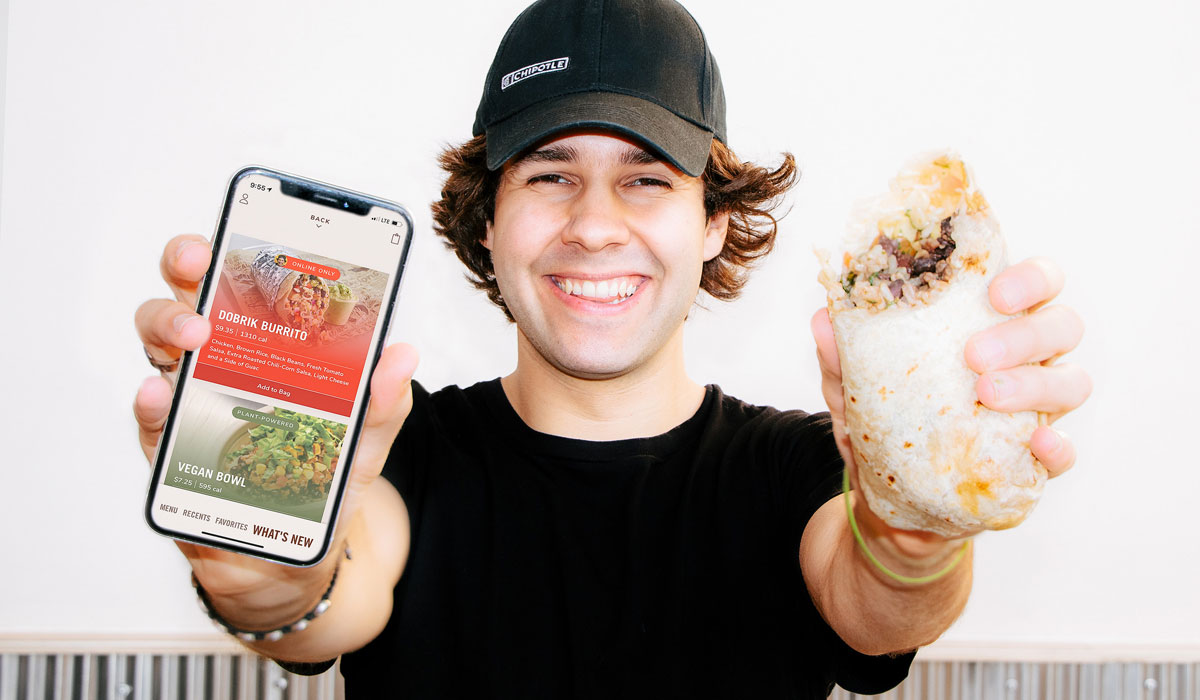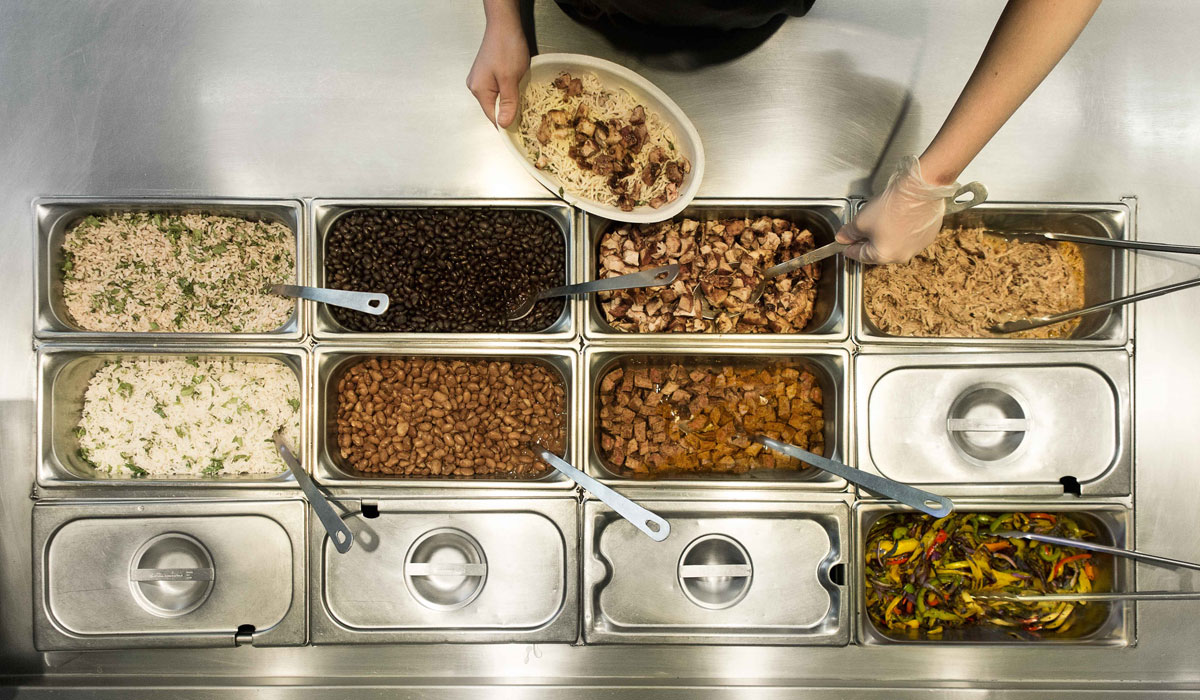Early on in Chipotle chief executive officer Brian Niccol’s tenure, he made a comment that took some by surprise. “This brand needs to be leading culture, not reacting to it,” he said in April 2018, less than a month after officially joining.
Niccol went as far to call Chipotle “invisible,” which is an interesting label for a 2,400-unit chain that essentially reinvented a category. But he wasn’t off base, either. Chipotle’s mission was transparent—purpose driven, ingredient forward—and so was its recovery story following 2015’s food-safety crisis. Yet was Chipotle speaking the language of its customers? That’s something Niccol set about addressing.
Last May, Chipotle brought in Tressie Lieberman. The chain’s VP of digital and off-premises spent two years with startup Snap Kitchen as CMO, but clocked close to five with Yum! Brands, holding digital roles at Pizza Hut and Niccol’s former stop, Taco Bell. Lieberman led an incubator at the Mexican giant focused on rapid prototyping, e-commerce, loyalty, and Slackbot ordering. She helped bring Pizza Hut’s first-in-category iPhone app to market.
Notably for the Chipotle move, though, Lieberman nurtured a strategy at Taco Bell that saw the chain transform into a lifestyle icon, especially among youth culture.
It’s to the point now where it’s easy to forget where Taco Bell stood nearly a decade ago. In 2011, it faced a public relations nightmare when a customer filed a lawsuit alleging that the chain’s taco mixture was more filler than beef. The suit was withdrawn, but Taco Bell’s image absorbed a blow.
Niccol was the brand’s marketing innovation chief at the time (he became president in 2013 and CEO in January 2015). During that run, and following the PR flare-up, Taco Bell worked its way into a hip concept that connected with a fresh generation of guests well beyond late-night menu items. That included hiring interns to run social media, devising a taco lens on Snapchat, and pushing Taco Bell’s products through Instagram via user-generated content. It set the stage for some of the offbeat creative you see today, like clothing lines, hotel pop-ups, weddings, and movie-like ads.
Taco Bell become the first brand on Snapchat under Lieberman’s watch and created a petition for the taco emoji. She also spearheaded the chain’s mobile ordering platform and social blackout campaign that surged Taco Bell to a top 20 paid app within its first day of launch.
Now, about a year and a half after joining Chipotle, it’s safe to say the fast casual is far from a cultural bystander.
Like many things at Chipotle, things are moving fast. Delivery launched just about a year ago. Rewards in March. “It’s such early days,” she says. “Never, ever a dull moment.”
As for what Chipotle changed to reroute the narrative, you can really start with tone. Chipotle remains serious about its food and core principles, Lieberman says, but the brand has taken on a lighthearted persona.
“We want to have fun with our customers,” Lieberman says. “That opens up opportunities.”
One example she references is Chipotle’s TikTok challenge. In August, the brand crushed internal records by selling more than 802,000 sides of guacamole for National Avocado Day. Adding fuel to the sales fire was Chipotle’s #GuacDance on TikTok, inspired by Dr. Jean’s viral guac song. It turned into the social platform’s highest performing branded challenge ever to run in the U.S., driving more than 250,000 video submissions using the specific hashtag, resulting in nearly 430 million video starts during a six-day run.

Lieberman says views are approaching a billion at this point. Chipotle needed an additional 7,500 cases and 187,500 pounds of avocados to meet the demand. In total, it served more than 420,000 pounds of avocados in a single day and required 18,500 cases—a 68 percent increase from typical usage.
“If you think about something like TikTok,” Lieberman says, “it’s a place for our customers where they’re certainly spending time talking about Chipotle. We wanted to speak to them in their language that they’re using on the platform.”
The #GuacDance activation was actually Chipotle’s second foray into the TikTok challenge space. The brand tried a #ChipotleLidFlip effort in May that asked customers to post videos of themselves flipping Chipotle packaging. It led to 110,000 user-generated video submissions and 104 million video starts in less than a week.
“What we’ve found is that when we meet our customers where they are and we do it in a Chipotle way, then they respond,” Lieberman says. “And we can really break through.”
It’s really about humanizing the brand—an often cliché point, but one that holds significant weight in Chipotle’s case. In February 2018, UBS analyst Dennis Geiger broke down several years’ worth of customer review scores to get a feel for Chipotle’s standing. His findings, along with a downgrade to sell from natural and a target-price cut to $290 from $345, sent Chipotle’s shares tumbling nearly 5 percent to $308.82 on February 1.
Chipotle was trying to flip consumer sentiment through a new national advertising campaign and products, like queso. The efforts weren’t landing, however, with enough force to scrub out sour feelings lingering from the E. coli outbreak that shut down 43 Washington and Oregon locations before erupting into a 14-state crisis and yearlong sales downturn.
Geiger’s data showed that Chipotle’s online scores hovered around 3.80 in March 2010. After analyzing some 230,000 entries, Geiger said, Chipotle witnessed a steady decline through November 2017. There was a brief rebound in March 2016, but the line trended downward soon after. And then a survey of 1,600 customers by UBS noted that 37 percent said they frequent Chipotle less often than they used due to food-safety concerns.
So, where are we today? For starters, Chipotle’s stock traded for $822 by mid-day Thursday.
The conversations center closer to digital breakthroughs, menu innovation, and culture-connected promotions than what happened four years ago, which is a welcomed change.
And that can be credited, in many respects, to Chipotle developing a voice customers can relate to, Lieberman says. Humanizing a brand that had an undeniable trust issue before.
“We don’t take ourselves too seriously and that allows us to have a great time with our customers,” she says. “We just talk to them as if they’re a friend of ours.”
Lieberman turns to a September campaign to illustrate this point. Chipotle has long known that its Tabasco bottles suffer from a short shelf life. Not that they go bad, but that customers like to swipe them. Chipotle, which goes through more than 5.5 million bottles annually, even posted before and after shots on Instagram. In the morning, there were bottles galore. By late afternoon, a lone survivor remained.
“Rather than shy away from that and hide the Tabasco bottles behind the counter, we started having fun with it,” Lieberman says.

To launch a free delivery on Sundays campaign in September, Chipotle introduced a “Things You ‘Borrow’ Kit” with boxes that included Tabasco bottles and utensils. Chipotle gave these out to the first 50 digital orders in select markets.
“That’s what you’ll see in our tone [now],” she says. “We’re having a great time with customers. We’re recognizing them.”
It’s a key shift. The way to look at it is that Chipotle isn’t so focused on dictating the message currently as it’s hoping to join in. “What we’ve found is that when we share content that taps into an insight about our community that they’re already talking about—that’s what gets them to hit or tap the like button, or double tap the Instagram post or engage in a challenge,” Lieberman says. “It’s really just tapping into what people already love about the brand and acknowledging that we hear them.”
Another example of Chipotle linking culture with passion, and using this to drive trial, can be found with digital products. To celebrate National Burrito Day in April, Chipotle offered customers free delivery on orders $10 or more. Sounds standard. But then the chain went a step further by partnering with YouTuber David Dobrik, making his go-to order Chipotle’s officially National Burrito Day option—the Dobrik Burrito.
The brand connected with Dobrik, who has more than 14 million subscribers on YouTube, and offered his signature selection exclusive online. It was preconfigured so guests (hordes of Dobrik fans, Chipotle banked on) could just go online and pick it with one push.
Niccol said during Chipotle’s second-quarter earnings call the brand enjoyed its highest sales day ever on National Burrito Day, “leveraging the social and digital experience,” although he didn’t provide exact figures. “More importantly, it was another opportunity to acquire customers and transactions by introducing them to the convenience of delivery, and we are seeing increased new customer retention with higher levels of delivery sales after the promotion,” he added. Chipotle’s same-store sales lifted 10 percent in the period, year-over-year, as revenue jumped 13.2 percent to $1.4 billion. The comp included nearly 7 percent of comparable transaction growth.

To Niccol’s point, much of Chipotle’s whitespace lately has come from driving awareness to its digital channels. Last October, Niccol said, “the No. 1 reason that consumers eat elsewhere is because they don’t have convenient access to Chipotle.”
That’s quickly reversed, too.
The brand dropped an eye-opening figure in April when it said that digital sales boomed 100.7 percent in Q1 versus the comparable period, up to 15.7 percent of total sales (the jump was 99.1 percent in Q2). Digital sales totaled $206 million that quarter as Chipotle averaged more than a million digital transactions per week. Digital impressions increased 300 percent, year-over-year, and social impressions skyrocketed 400 percent. And nearly half of the guests who engaged with Chipotle’s free delivery bowl offer from December 17 to January were new or lapsed users, the brand said.
A year ago this month, Niccol said Chipotle’s internal data showed there was less than 50 percent guest awareness with its digital platforms.
Lieberman notes free delivery promotions have gone a long way to lowering the barrier for people to try it for the first time. And, in time, Chipotle chipped away at that figure.
The Dobrik burrito is one case study in how Chipotle leveraged social conversation to spark orders, and then used digital to reduce friction. Another is the Lifestyle Bowls promotion it brought to life in January to build off healthy-eating resolutions. The Paleo, Keto, and Whole30 options didn’t require Chipotle to add any new ingredients. It simply packaged the bowls digitally so customers could easily order them without customization.
During the first few days of launch, Niccol said, Chipotle generated more than a billion earned media impressions. Later in the quarter, it extended the platform with plant-powered options.

“Through social listening we found that there was a problem with people who wanted to eat Whole30 or they wanted to eat Keto, but they had to do some effort. They had a lot of work to figure out, which ingredients to remove and so on. With digital, we have the power to make that a one-touch experience for people,” Lieberman says. “We can remove a ton of friction.”
Chipotle has done similar things to inspire delivery orders since, like partner with the USWNT during the World Cup to feature stars’ favorite orders exclusively online along with free delivery. It gave away close to $1 million in free burritos as part of a mobile promotion around the close of the NBA season. Every time a reporter said “free” on-air, Chipotle sent out codes via Twitter diners could text to a special number.
And this hasn’t even touched on Chipotle Rewards yet, which went national with a Venmo partnership that gave away up roughly $250,000 to 25,000 guests. Chipotle customers submitted the phone number associated with their account at ChipotleRewardMe.com for a chance to receive anywhere between $1–$500. Within 24 hours, recipients of the payouts were alerted of the payment in the Venmo app with a note from Chipotle along with a custom pepper emoji—a first of its kind in the restaurant industry on this platform.
“It’s another way to drive culture,” Lieberman says simply.
In the past, this was batch and blast,” she adds of rewards. “Let’s get the same message out for everyone. Now, we have intimacy at scale.” Chipotle had about 6 million members by mid-summer.
Headed into the future, expect to see much of the same from Chipotle, yet a few surprises tossed in along the way. Lieberman says the brand will continue to listen and see where it can engage customers and tie its promotions to social events. But the brand won’t be afraid to take risks and experiment. “It just never stops,” she says. “I think we’ve got some power of great, flexible digital products as well as a brand that people love and the ability to leverage social media to help share these stories. We’re having a lot of fun doing it.”





